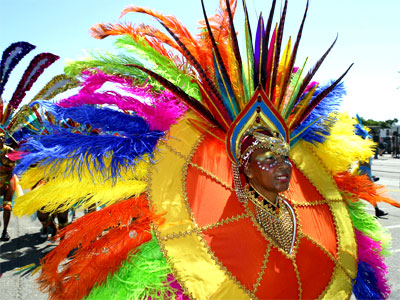Caribana, exploitation and disrespect of cultural resource
Caribana, exploitation and disrespect of cultural resource

By AJAMU NANGWAYA
While the April 2010 news of the $438 million economic impact of Caribana is worthy of celebration and all the media attention that it has generated, I hope that as Canadians we will open our eyes to the monumental failure of government funding of this phenomenal cultural festival. An Ipsos Reid Economic Impact Study clearly established that Caribana is the most lucrative festival in all of Canada. Yet the Calgary Stampede which attracts millions of dollars in annual government funding is touted as the largest "Canadian" festival with its $173 million economic impact over 10 days.
It is estimated that Ontario's cultural institutions bring in a yearly income of $4.5 billion, while attracting 3 million patrons. About 1.2 million people participated in the 2009 edition of Caribana and over 300,000 of these revelers came from abroad. It ought to be clear that dollar-for-dollar, Caribana's economic performance leaves its more favoured cultural competitors in the dust.
In April 2009, the Government of Ontario announced $43 million in funding to six cultural organizations that were reflective of Anglo-Canadian cultural dominance. The Arts Gallery of Ontario received a $10 million operational grant and an additional one-off gift of $8.6 million. The Royal Ontario Museum received an operational grant of $9 million and a one-time funding support of $7.2 million.
Yet, in April 2010, it was announced that the Ontario Liberal government will give its Cinderella of a cash cow, Caribana, an insulting grant of $484,000. In 2009, the provincial government in Alberta gave a $10 million operating grant to the Calgary Stampede, which sent a bold message of the festival's status as a part of that province's cultural infrastructure.
The City of Toronto will be offering a grant of about $500,000. Last year the federal government ponied up $415,000, but got back over $108 million in tax receipts from this cultural golden goose. Yet this same federal government gave $5 million to the Calgary Stampede from its Western Economic Diversification funds. This allotment of resources to this Western festival was in addition to $1,819,234 from the Marquee Tourism Events Program.
In my judgment, the miserly level of funding from the City of Toronto, the Government of Ontario, the Government of Canada and the business sector has much to do with the perception of Caribana as a cultural outsider - the multicultural 'Other'. Further, the people who are the driving force behind the festival are themselves culturally peripheral to the Canadian cultural-cum-political project. If the McMichael Canadian Art Collection, Ontario Science Centre, Royal Botanical Gardens and Ontario Heritage Trust could received grant funding of between $2.5 -$3 millions in April 2009, certainly Caribana with its huge cultural, social and economic footprint doesn't merit being treated like the "black sheep" of the artistic family.
African and Caribbean peoples, the creators of the Caribana festival, are minor economic beneficiaries. But their countless volunteer hours are indispensable to the enormous income that goes into the Canadian economy. It is high time that Caribana be given millions of dollars in annual operational and project funding so as to enable it to operate as a year-round cultural institution.
Further, this festival should contribute to the economic and social vitality of the African and Caribbean community. It is high time for Caribana to not be treated as an economic resource that is exploited for the benefit of the corporate interests and the government. The three levels of government and large corporate sponsors have a neo-colonial relationship or a system of indirect rule with Caribana through the Festival Management Committee (smacks of British colonialism in Africa).
In 2006, the City of Toronto threatened to defund Caribana. It made this move, because of concerns about how the festival was being managed by the Caribbean Cultural Committee. This community-based group was pushed to the sidelines and the Festival Management Committee was elevated to the status of organizer-in-chief. The city's action sent a clear message about who had de facto control and "ownership" of this summer cultural extravaganza. That act of brinksmanship by the city and other funders affirmed the notion that "he who pays the piper calls the tune". The state through its funding of the festival has an effective veto over the people from within the African and Caribbean community who are deemed fit to organize this festival.
Yet, if we become better politically organized as a community and with Caribana's economic impact, we have the ability to make this festival one that benefits its creators and be under our effective control.
The benefits should be largely channeled through community-controlled programs and institutions such as community centres, educational scholarships, museums, arts centres and initiatives that will generate employment and other opportunities. It is time for us to force the different levels of government in Canada to move beyond anti-racist and equity policy pronouncements and empty promises and live up to the ideals of equity for all. The inequitable funding of Caribana has effectively demonstrated that political hypocrisy is at work in the cultural policy of the political directorates.
Ajamu Nangwaya is a trade unionist with the Canadian Union of Public Employees (CUPE). He is a doctoral candidate at the University of Toronto.
This commentary appeared in the August 3, 2010 issue of the Share Newspaper (http://www.sharenews.com/opinion/2010/08/04/caribana-exploitation-and-di...)

